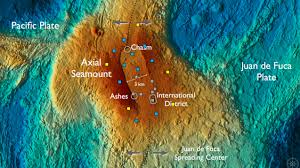Axial Seamount : New Study

Scientists are currently on high alert while observing the Axial Seamount volcano, which is set to erupt for the first time in a decade.
- Axial Seamount is an underwater volcano located about 300 miles off the coast of Oregon, United States in the Pacific Ocean.
- It is a shield volcano with a summit marked by a large caldera.
- It rises to a depth of 1400 m below sea level.
- It is formed by a hot spot, an area in the Earth’s mantle where hot plumes of molten material rise into the crust.
- It is located on the Juan de Fuca Ridge, the boundary between the Pacific and Juan de Fuca tectonic plates.
- The volcano is home to hydrothermal vents, underwater hot springs where seawater is heated by magma and ejected in mineral-rich plumes.
- These vents support diverse marine life, including microbes that use volcanic gases for energy, forming the basis of an ecosystem that includes giant tubeworms, spider crabs, clams, fish and octopuses.
- It is the most active submarine volcano in the northeast Pacific, with known eruptions in 1998, 2011 and 2015.
- While Axial Seamount’s eruptions are not dangerous to people on land, they offer valuable opportunities for scientific observation.
- It is part of the Ocean Observatories Initiative (OOI) and hosts the world’s first underwater volcanic observatory called NeMO.




